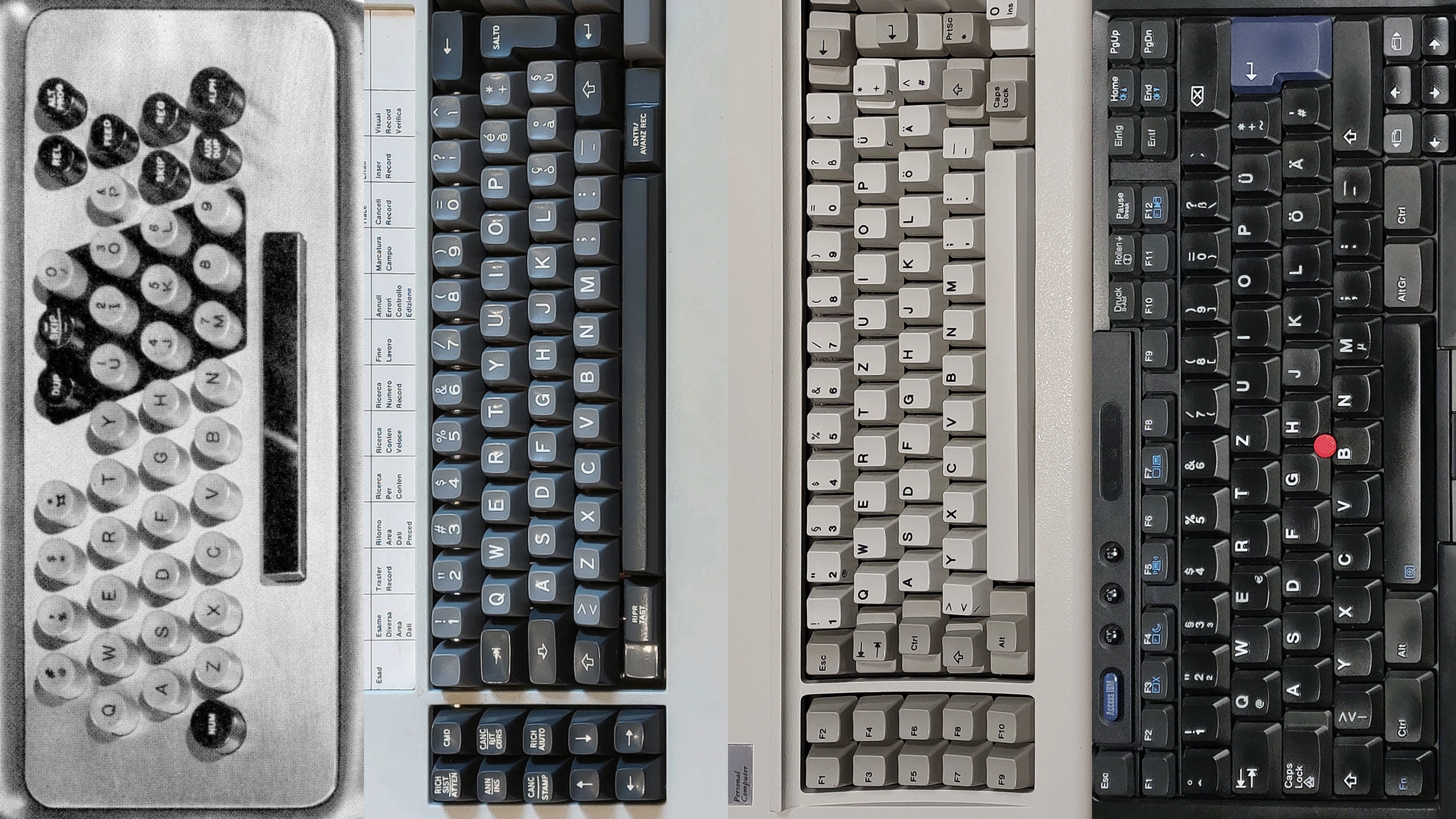The IBM and family keyboard timeline is an illustrated overview of some of the most important events affecting IBM, Lexmark, Unicomp, Lenovo and Toshiba Global Commerce Solutions keyboards. This includes notable keyboard releases and withdrawals, corporate history like company founding, divestures and change in OEMs, and patents. Due to their relationship and impact on the keyboards around them, host devices such as personal computers, terminals, consoles and typewriters also appear throughout the timeline. 145 events have been recorded for the "show all" versions of the timeline.
[ASK] Herman Hollerith patents the first keypunch (apparatus for perforating record-cards). This patent will be implemented as the Hollerith 001 Mechanical Card Punch, which upon IBM's founding, became the IBM 001 Mechanical Card Punch and their first product.
Reynold B. Johnson patents for IBM United States an alphanumeric keypunch keyboard layout that integrates a telephone-arrangement overlay numeric keypad, numeric shift and keypunch-specific function keys onto a keyboard's typewriter section. It is first implemented on the IBM 024 Card Punch and 026 Printing Card Punch Combination Keyboards, and will go on to serve as the basis for many future IBM data entry keyboards.
[1] Jim Ladue and Werner Seydel patent for IBM Germany and IBM United Kingdom a "keyboard divided into two mirror-image fields", an early design for a split-ergonomic keyboard. It is intended for typewriters or similar machines, allowing the user to position their arms and hands at more natural positions and rotation. Whilst IBM never brought this exact product to market, this patent will be cited by well-known ergonomic keyboard companies such as Kinesis and Maltron (Lillian Malt).
Richard Hunter Harris invents and patents the buckling spring (catastrophically buckling compression column switch and actuator) for IBM. This keyswitch actuator is comprised of a metal coil spring that characteristically buckles into a kink instead of compressing in a straight column, which pivots something that can be registered by some sort of sensor. The exact design is not yet solidified, but IBM will later patent two marketable derivatives in 1977 and 1983.
[ASK] Richard Hunter Harris and Robert John Wolfram patent the beam spring (switch button with snap mechanism) keyswitch for IBM. The design has a leaf spring that rests at a downwards bent position, which when force is applied, snaps to an inverted position. The movement lifts a capacitive fly plate away from a pad card that can perform capacitance sensing, which is interpreted as a key press.
[ASK] Richard Hunter Harris patents the "buckling spring torsional snap actuator" for IBM, a refinement of the original 1971 buckling spring patent (US3699296A) that uses capacitance sensing via a pad card. This design is what will be brought to market as capacitive buckling springs for Model F family keyboards in a few years.
[ASK] Edwin T. Coleman, III patents the "rocking switch actuator for a low force membrane contact switch" for IBM, which will be brought to market in a year as membrane buckling springs for Model M family keyboards. It is still based on the same core mechanics as its 1977 (US4118611A) predecessor, but a membrane assembly for ohmic sensing is now used instead of a pad card for capacitance sensing. This change is intended to reduce its manufacturing cost by "approximately half" compared to its predecessor.
[2] Joseph E. Jasinski, Charles H. Lingle, Richard F. Pollitt and David W. Shuman patents for IBM Information Products Corporation a combined, reversible ball mouse and trackball device that will be used for a IBM Personal System/2 L40 SX notebook computer accessories called the TrackPoint.
[ASK] Edwin J. Selker and Joseph D. Rutledge patent the concept of a pointing stick for IBM Information Products Corporation. It will soon be implemented on IBM products as the TrackPoint II, III and IV pointing sticks and will become a hallmark feature of ThinkPad laptops.
Robert C. Barrett, Robert S. Olyha, Jr. and Joseph D. Rutledge patents for IBM a formula for a negative inertia transfer function that can be used to help pointing sticks to counteract the feeling of sluggishness (i.e., having inertia). It was implemented in TrackPoint III's and TrackPoint IV's firmware, making them more performant with modern, high-resolution displays compared to TrackPoint II. For ThinkPads, it first appeared on the IBM ThinkPad 755CD.
- IBM - Improvements relating to typewriter keyboards [accessed 2025-04-01]. License/note: provided by Google Patents, figures used under fair dealing.
- IBM - Combined mouse and trackball [accessed 2025-03-21]. License/note: provided by Google Patents, figures used under fair dealing.
